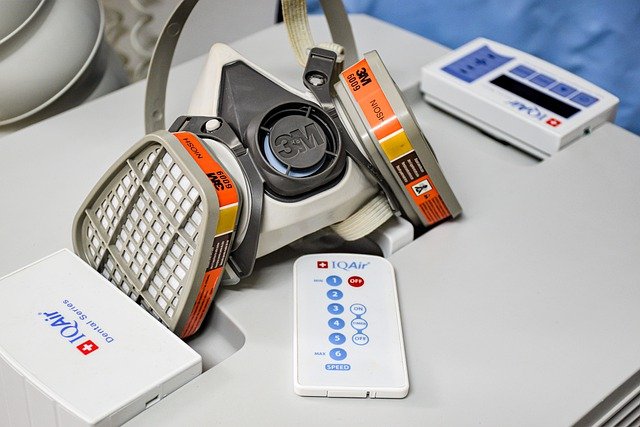Working in a closed system, air purifiers use fans to suck in the outside air. The air is then filtered and pushed out as clean air. The filters of the air purifier is made out of – paper, fibreglass, fibre and mesh
Following the festival of Diwali, deterioration in the air quality levels has been rampant everywhere, particularly in Delhi-NCR, with Air Quality Index plummeting to ‘severe’ category.
And with Winter, air pollution in India is going to once again hit crisis levels soon. Climatic features such as the drop in temperature and slowing of wind speed also determines how long the pollutants hover in our immediate atmosphere.
The onset of winter conditions – cool and low wind speed, temperature inversion, rapidly increasing farm fires and overall trapping of pollution – may trigger the season’s first smog episode soon.
Prolonged exposure to air pollution can manifest into long-term health consequences. One of the most common symptoms experienced are burning sensation and itchiness in the eyes, throat allergies, headaches and breathing difficulties. Pollution levels right now could also be especially concerning, considering that we are already facing a bad influx of viral infections.
Installing air purifiers can be one of the options to lessen the risk of developing pollution-related health problems.
Let’s talk about how an air purifier works and are they effective at improving the local air quality.
How does an air purifier operate
Working in a closed system, air purifiers use fans to suck in the outside air. The air is then filtered and pushed out as clean air. The filters of the air purifier is made out of paper, fibreglass, fibre and mesh.
The good purifiers have multiple layers of filter that have to be replaced regularly to remain effective. For larger particles, air filters are usually reusable and require to be meticulously washed. Among larger air impurities, pollutants range from pollen to dust mites.
Most devices in the market rely on mechanical filtration to clean the air and are rated by Clean Air Delivery Rate (CADR). Based on the coverage area for the end-user segment, the filters are classified as 300 sq ft for automobile, between 300 square feet to 500 square feet for residential and 500 square feet for commercial and industrial spaces.
Why is an air purifier important
To improve the quality of indoor air, it is crucial to reduce or remove the sources of pollutants and to ventilate with clean outdoor air.
Filtration is an effective supplement to control ventilation. Using a portable air cleaner in your furnace or central heating, ventilation, and air-conditioning (HVAC) system can help to improve indoor air quality. Air purifiers are designed to filter the air in a single room or area.
A study published in the British Journal of Psychiatry tracked 13,000 participants in London and found that reducing the volume of small particle pollution by even a few percentage would make a huge difference to mental health.
Pollutants air purifiers protect us from
According to the Environmental Protection Agency (EPA), High efficiency particulate air (HEPA) filters are pleated mechanical filters that can remove up to 99.97 percent of airborne particles, including dust, pollen, bacteria, and mold.
The EPA recommends looking at an air purifier’s minimum efficiency reporting value (MERV) to determine a filter’s ability to capture particles between 0.3 and 10 microns. A higher MERV means that a filter will be able to remove more particles.
Commonly used air purifiers
One of the most widely used air purifiers contain HEPA filters. This filter comprises of multi-layered meshes made of fine fiberglass threads, thinner than strands of hair.
Typically, a virus dies in under 48 hours across a range of surfaces. These viruses prefer wet materials as they don’t survive well on dry materials. The HEPA filters inside most air purifiers are constantly bombarded with high-velocity air, which would dry out any virus. Technically the virus that causes COVID-19 is approximately 0.125 microns (125 nanometers) in diameter and HEPA filters are capable of capturing them with an extraordinary efficiency of over 99.9 percent.
Different types of features available within air purifiers
HEPA filter: An air purifier with a HEPA filter will remove more particles from the air compared to one without a HEPA filter. However, look out for terms such HEPA-type, or HEPA-style, as there’s no guarantee that this will conform to industry regulations.
Carbon filter: An air purifier with a carbon filter will also capture gases and volatile organic compounds (VOCs) that are released from common household cleaning products and paints.
Sensors: An air purifier with an air-quality sensor will activate when they detect pollutants in the air, and will often provide information about the quality of the air in the room it’s situated in. In addition, a smart air purifier will send detailed reports directly to your smartphone, so you can easily monitor your indoor air quality.
Effectiveness of an air purifier
Researchers point out that there is not enough evidence investigating whether UV and HEPA air purifiers can protect against respiratory illnesses.
The Environmental Protection Agency (EPA) states that people should not buy air purifiers that emit ozone. These can include UV air purifiers, electrostatic precipitators, ionizers, and plasma air purifiers.
Ozone is a colourless gas that is naturally present in the Earth’s atmosphere and protects people from the Sun’s harmful UV rays. However, the air pollutants and chemical reactions can still lead to ozone formation at ground level.
The Environmental Working Group also recommends people to use purifiers with a HEPA filter, as these are ozone-free. They remove particles such as mold, pollen, bacteria, and viruses from the air.
Need of the hour
Manufacturers are optimistic about the growth potential of the air purifiers market in India. Businesses and key players are taking innovative steps to reopen and put life back to normal with even smarter and safer solutions than before. The demand for air purifiers is also growing due to other factors like growing knowledge on air purifiers coupled with consciousness among customers.









